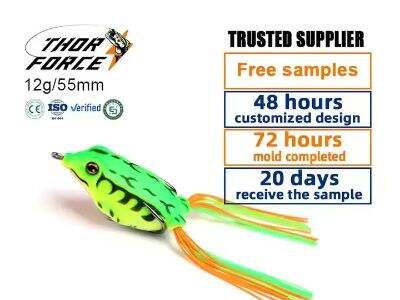Fishing is a great hobby, and many people do it. But fishing requires skill and patience. When it comes to fishing, I have one last, important lesson for you about a soft lure color selection under different scenarios, that's the bit of knowledge you will find useful if you truly enjoy to fish. Soft lures Happy View are unique gadgets that are available in a wide variety of colors, shapes, and sizes. Selecting an appropriate color could mean the difference between catching a few fish vs no fish at all.
Know Your Fish's Food
First, you need to be aware of what your target fish consumes. Different fish have different feeding habits and preferences. If you are catching mostly non-aggressive species like bass, it helps to know what food bass like, what colours are their natural food, and other factors. Bass typically feed on small fish, frogs, crayfish and insects. This knowledge aids you in selecting soft lure colors that mimic the natural prey of bass. This soft lure plastic gives you a running start on catching more fish because fish are attracted to things that look familiar to them.
Water Clarity and Water Light Conditions
Water clarity and level of light in the environment are another important considerations. Water clarity is how clear or muddy the water is. Fish have better color vision in clear water. So for your lures you want to mimic real food with natural colours. For instance, if your lures were green, they should represent the water plants or insects. Use brighter colors in less clear water as it is better seen by the fish. In this way, even if the fish can’t see well, they will be able to see your lure.
Light conditions also influence how fish perceive colors. Use bright and shiny colors that are easily visible to the fish on cloudy days or at dark. For example, bright yellow or silver lures will attract fish in low light situations. On sunny days or in bright light, however, you’ll want to go for more natural-looking colors that resembles the foods they eat in their natural habitats. Which involves using colors that match the environment, so the fish feel comfortable and bite more often.
Trust Your Instincts
Finding a perfect soft lure colour may require some practice and experimentation until you discover what the fish really attracts them. But you can also follow your gut. If you’ve gone through many colors and none work, consider going with a color that you are comfortable with or one that has worked for you in the past. the color, for example, that a fish would not necessarily be a fish attracted to a specific thing but to how that same soft lure will move in the water. So, ensure that your soft lure has a very realistic action akin to the swimming motion of their natural prey. How your lure moves can be just as important as how it looks in the water to whether or not the fish will hit it.
Be Ready for Changes
If not, then adjust and be prepared to do so all the time, because conditions in fishing change rapidly. So throw away the lures that are reliant on exact colors, etc and replace them with softer variations of those that you catch best in a wide range of water conditions. Fluorescent colors work well in dirty water while neutral colors like brown, green, and black are excellent because they can be used in just about all types of water (clear or dirty, bright or low light). This makes soft lures with more than one color a good choice for building a fishing rod, as many fish have such a color pattern in the wild. Such versatility is useful to stay ready for any situation you might encounter while fishing.
Targeting Specific Fish
When coming up with colours for your best soft lures, it is to your advantage to consider the different preferences for different fish species. Soft lures that are lighter in color are better when you are targeting crappies, for instance. Light-colored baitfish are crappie favorites. Soft lures are again more attractive to bass; these larger fish tend to feed on bigger, darker prey. If you can match the color of your lure to what type of fish you want to catch, you mix make these fish more successful.
So, to wrap up; the colour of your soft lures will be a key factor in determining your fishing success. You need to know what kinds of food the fish you target like to eat, how water clarity and light conditions affect color choices, and trust your instincts when it comes to selecting colors. Choose soft lure colors that allow for quick adjustment of your technique and simply select the colors that match the species you want. Happy View has a huge selection of soft lures in a variety of colors, shapes and sizes for any fishing scenario. Just remember next time you are fishing to experiment with different colors until you find the one that works best for you. Good luck and happy fishing!

 EN
EN
 AR
AR
 HR
HR
 CS
CS
 DA
DA
 NL
NL
 FI
FI
 FR
FR
 DE
DE
 EL
EL
 HI
HI
 IT
IT
 JA
JA
 KO
KO
 NO
NO
 PL
PL
 PT
PT
 RU
RU
 ES
ES
 SV
SV
 TL
TL
 IW
IW
 ID
ID
 LV
LV
 LT
LT
 SR
SR
 SK
SK
 SL
SL
 UK
UK
 SQ
SQ
 HU
HU
 TH
TH
 TR
TR
 AF
AF
 MS
MS
 GA
GA
 CY
CY
 MK
MK
 KA
KA
